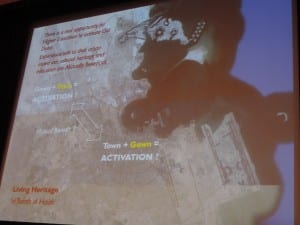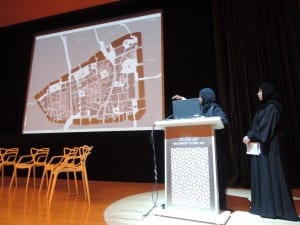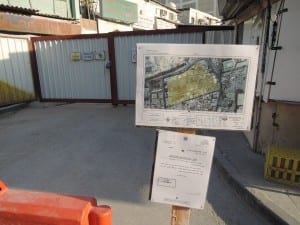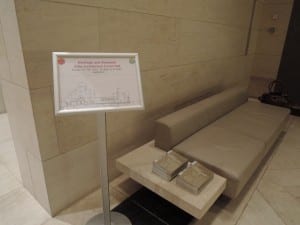Universities must make the running on culture and societal issues
By ucqbcme, on 4 December 2014
Teesside and Cardiff Universities were singled out for special mention by HEFCE’s Chief Executive, Professor Madeleine Atkins, in her plenary talk on universities as place-makers and anchors, at the NCCPE conference this week. Teeside, she said, by taking on MIMA (Middlesborough Institute of Modern Art) and ‘embedding it into the community’, was a prime example of how universities can intervene in the fate of museums and cultural organisations hit by ‘catastrophic funding cuts’ to local authority budgets, and develop them as cultural assets for the future by bringing in local communities. Cardiff, demonstrating not only how universities can take a lead in social innovation initiatives, but also that ‘the English are always one beat behind the Welsh!’, is the first university to open a social science research and innovation park (SPARK) – although a ‘few clones’ are now coming through in its wake. Staff and students in many universities are also now assuming or supplementing roles formerly played by local authorities or the voluntary sector, drawing on new forms of financial support such as Social Innovation Bonds.
Atkins used the examples to illustrate two in her five-point framework for a university-wide renewal of principles originating in the 1960s and 1970s around place-making and social engagement. For, as she said, the arrival of the 39 Local Enterprise Partnerships and European Structural Funds for regional development represent ‘the only secure source of funding for universities over the coming years’, and universities therefore need to embrace a multi-disciplinary approach related to the Grand Challenges to drive thinking and dynamics around engagement. She identified five specific areas in which this should occur: engagement with local schools; local skills agendas; social innovation and social enterprise; cultural engagement; and local economic growth.
HEFCE is encouraging universities to explore these routes through a number of initiatives. It will fund new local collaborative networks, in a programme to be announced by the government after Christmas. It has launched a tracker system, HEAT (Higher Education Access Tracker), to follow what types of engagement really work in terms of encouraging young people into Higher Education from school age level, and she commended the efforts of universities in establishing new academies and intervening in existing schools to raise academic achievement – although she also confided, ‘let’s hope those schools don’t go into special measures!’ She also noted that HEIF funding is being channelled into a social investment agenda through partnerships designed to promote local social cohesion and social confidence – and in turn attract inward investment (SEE Change). Furthermore, 20% of marks awarded in REF assessments will now be awarded to the Impact Case Studies, which will become accessible on a searchable database due to be launched after Christmas by HEFCE in parthership with Macmillans and researchers at Kings College London.
Finally, HEFCE’s call for proposals for being ‘a really fantastic anchor’ (Catalyst Fund) received 66 expressions of interest this week, and participants will be invited to work up full proposals for a ‘new model’ of anchoring institution by March next year.
Asked how close she thought we were to delivering that integrated vision of HE and place-making, she expressed optimism in the fact that Greg Clarke as combined Minister for Cities and Higher Education is ‘absolutely focused on this agenda’. However her concerns lie with the fate of towns in rural areas ‘at the end of the line’, and often around the coast, which ‘desperately need that stimulus’ but find they have fallen off the map. She also urged universities ‘to make the running’ with LEPs that may appear to have little interest in cultural and societal issues compared to hard economic growth
Before dashing off to discuss the Autumn Spending Review in London, she delivered a final one-line response to an invitation to comment on the government’s commitment of funds to UCL and UAL’s expansion initiatives on the Olympic Park, and whether they would benefit the local community: ‘Let’s hope so. I don’t see why not.’
For further information on the National Co-Ordinating Centre for Public Engagment’s annual conference (Dec 3rd and 4th, Bristol): www.publicengagement.ac.uk. Clare Melhuish (UCL Urban Laboratory), Kim Townsend (UCL Public Engagement), Andy Karvonen (University of Manchester Architecture) and Sam Wilkinson (InSite Arts) ran a workshop titled ‘Engaging places: insights on engagement through university spatial development’.
‘Town to gown’ or ‘gown in town’: campus v integrated urban models of higher education development
By ucqbcme, on 18 November 2014
The potential role of higher education in ‘activating’ city centres all over the world, as opposed to generating conflict between ‘town and gown’, was highlighted at the launch on Sunday of UCL Urban Laboratory’s Urban Pamphleteer #4, dedicated to issues around the rapid redevelopment of the historic centre of Doha, Qatar. The event, held at Doha’s most recognizable landmark, the Museum of Islamic Art, concluded with a presentation from Tim Makower, a British architect based in London and Doha, who stated ‘there is a real opportunity for higher education to activate old Doha. Experience tells us that urban mixed use, cultural heritage, and education are mutually beneficial’.
Makower, who played a central role in the masterplanning and design of Doha’s fast emerging Msheireb Downtown development, was also the driving force behind the Old Doha Prize (2013) organised in Doha in collaboration with the British Council, UCL’s Bartlett School of Architecture, the RIBA, and Qatar Museums Authority. The competition, which paired selected Qatari and British collaborators, asked teams to make proposals for a sustainable, heritage-led regeneration strategy for the Al Asmakh neighourhood on the boundary of the Msheireb development. The fate of this neighbourhood, comprising narrow streets of dilapidated old mudbrick courtyard houses, small local shops, and some newer structures, inhabited by a long-standing, recently evicted, community of Doha’s migrant workers from Nepal, India and Sri Lanka, had been under question for some time.
The winning team, youandme architecture from the UK, with Fatima Fawzy and Alaa Larri from Qatar, came up with a strategy for sensitive redevelopment which puts education at its heart. The hope is that Qatar’s planning authority and government officials will be influenced to produce plans for the Al Asmakh area, now an exclusion zone marked off by barriers, which take some of these ideas on board.
Urban planning in Doha has been dominated by a zoning-based approach for many decades, resulting in a highly segregated city where residential areas, shopping and leisure zones, and commerce occupy clearly bounded territorial areas. Doha’s higher education facilities are concentrated in two principal zones, that of Qatar University near West Bay business area, and the newer, ever-expanding, Education City campus – a 20-40 minute drive from the centre depending on the traffic, with no public transport links. Education City includes a number of ‘branch campuses’ of mainly US universities, plus UCL Qatar, a postgraduate centre for studies in heritage, museums, and archaeology, as well as Qatar Faculty of Islamic Studies, and the Qatar Foundation. It is co-located with Qatar Science and Technology Park, where it is hoped that university-generated research will undergo commercial application. It is also the home of Qatar Academy, an all-through school geared towards university entrance, the Qatar National Library, a stadium, and extensive residential student accommodation.
The Education City campus is notable for its pleasant, peaceful gardens and open spaces, a collection of remarkable buildings designed by top-ranking architects such as Legorreta, Koolhaas, and Isozaki, and a wide-ranging programme of educational and cultural events. Qatar University is also architecturally noteworthy, designed by El Kafrawi, recipient of an Aga Kahn award – and currently expanding on its own campus. But both sites lie at a distance from the city centre, drawing both people and teaching and research-related activity out of it.
Both Makower and the Old Doha prize winners, speaking at the Urban Pamphleteer launch, agreed that the current regeneration of the city centre could benefit greatly from a re-integration of ‘town and gown’, animating the central areas with a range of education-related activities at the core of a new mixed-use approach to development, leavening the historic emphasis on city-centre business and retail: ‘Student life and education have a proven track record to regenerating areas. They can also enable a step-by-step regeneration that adapts to its socio-economic context. In Doha, zoned areas such as Education City and Katara Cultural Village, positioned on the edge of the city, take away a lot of life and activity from the centre. Why not have these activities happening right at the heart of Old Doha?’ (Alicja Borkowska, youandme architecture).
For further information: Urban Pamphleteer #4: Heritage and Renewal in Doha, guest-edited by Clare Melhuish, series editors Ben Campkin and Rebecca Ross, available in print and as a digital pdf.
It will launch in London on Nov 27th at UCL. For further details: http://www.ucl.ac.uk/urbanlab/events/urban-pamphleteer-4-london-launch
‘Silicon Alley’ v Silicon Valley: urban planning for science and innovation-led development
By ucqbcme, on 4 November 2014
The CityAge: Global Metropolis event in London highlighted common challenges faced by cities around the world, along with the instrumental role of universities in delivering the potential for urban development through science and technology research, innovation and commercial translation. Bringing together some high profile speakers, including Alicia Glen, New York’s Deputy Mayor for Housing, and Boris Johnson, Mayor of London, it demonstrated that cities as similar and diverse as London, New York, and King Abdullah Economic City in Saudi Arabia, are looking to higher education establishments to generate activity in these fields as part of an overall strategy for urban growth, quality of life, and prosperity. And also that new graduates in the tech and innovation industries are showing a strong preference for urban centres as places for integrated work and living over the out-of-town science parks and campuses developed during the last decades of the last century.
As Glen put it, ‘Silicon Alley’ has become more appealing than Silicon Valley. In New York, the opening of Cornell Technion University on Roosevelt Island is part of a major drive to attract talent in competition with new innovation cities such as Austin and Denver and diversify the city’s economy, which currently relies on a few high impact industries. The finance sector notably accounts for 30% of the city’s payroll, but only employs 9% of its workers. Combating inequality has been recognised as central to maintaining New York’s competitiveness. This includes not only creating new jobs in the tech sector, focused on physical innovation clusters around the city, but also making changes to planning and land use policies, and imposing ‘aggressive, mandatory’ obligations on developers to provide affordable housing (subsidised by the city authorities) in order to stop low-income and middle-class citizens being squeezed out. In addition, it requires heavy investment in infrastructure across the five boroughs to re-align historic transportation systems with the locations where people are living and working today.
Noting that the challenges between London and New York are ‘remarkably similar’, Glen’s comments prefaced Johnson’s announcement of a new name for Cross Rail 2 – the Winston Churchill Line – and a commitment on the part of City Hall to finding half the £20bn funding required to ensure completion by 2028. Johnson stressed the importance of the line to supporting a 15% increase in the number of people able to access London’s central economic zone within 35 minutes, as well as ‘tens of thousands’ of new homes in the Lea Valley. These fall within designated Opportunity Areas created to ‘make housing work’ through mixed-use development – typically ‘city fringe type areas’, as Ed Lister put it, which appeal to tech companies, and are also tempting some of London’s major universities (cf UCL East and Imperial West) to put down roots as potential anchor institutions for new innovation clusters with local as well as wider economic impact.
As in New York, these developments have involved re-thinking urban land use and planning policy, and are highly structured by local development plans and masterplans. But a word of warning was offered by Fahd al Rasheed, CEO of King Abdullah Economic City. As one of five new planned cities in Saudi Arabia designed to host new investment in science, technology and related industries, in order to diversify the oil-based economy and create jobs, it incorporates a new multi-university campus and the King Abdullah University of Science and Technology, to support the development of home-grown, globally competitive, talent. However the original masterplan was, said Al Rasheed, ‘over-engineered and not ecological at all’. In his words, the process had taught them ‘one lesson: never stick to a masterplan; it only tells you what you should not do’.
Universities challenged by race for space
By ucqbcme, on 13 October 2014
The NLA’s recent conference (London’s Education Estate) emphasised both the role and reponsibilities that universities have in regeneration processes in London, especially in deprived areas, and their increasing integration into a continuum of educational facilities and opportunities alongside schools, FE colleges and other institutions, rather than existing at several removes in a world of stand-alone HEIs.
However, universities will have to move fast to have any chance of acquiring the extra space they need to enhance their capacity. Savills’ Matt Oakley pointed to a 199% increase in universities leasing office space, but warned that they are ‘competing head-to-head’ with office tenants in an open market. Since rents will increase by 5% per anum over the next 5 years, and leases are long, the risks are also high. And they’re also competing with residential clients and many new non-London and foreign ‘education brands’ which are attracted to London by its perceived safety, its welcoming multiculturalism, and the opportunities for part-time jobs. Such incomers are fast absorbing any excess space.
So what are the spatial options for London’s universities wanting to play their part in the city’s economic growth and stay competitive? Virtual expansion is only part of the answer – completion rates on MOOCS stand typically at only 5-10%, but rise to 30%-100% when physical learning hubs are provided. As Andrew Grainger, Director of UCL Estates pointed out, universities do have a significant advantage as blue-chip organisations in the search for space, which is access to ‘very attractive’, blended funding sources. And both UCL and Kings College, represented by Ian Caldwell (Director of Space Management and Facilities Advisor), are securing significant stakes in London’s hotly contested property market, both looking eastwards – UCL to Stratford, KCL to Canada Water. KCL has an aspiration to grow by 3,000 students in the next 5 years, to match UCL – but in both scenarios, the institutions are also playing the role of ‘anchor tenants’ in local regeneration.
Grainger described the LLDC and LB Newham as ‘both very benign in wanting to support university development’ in Stratford, and the site in the south of the Olympic Park as potentially ‘a fantastic educational hub’ with informal facilities on campus designed to create a sense of community. He said the initiative would contribute to ‘breaking down the barriers of Bloomsbury’. KCL surprised the local planning authority (Southwark) by rejecting the idea of a ‘gated community’ on the site, and embracing integration into the urban grain, while also supporting local schools. However, they had been disappointed by the LA’s lack of reciprocal support for staff residential housing on site, a resource in scarce supply, and insistence that provision should go to an RSL. The local community, for its part, had welcomed the idea of an influx of young people generating a daytime economy in the area; and not one objection to the proposal for 770 new student residential units had been received.
Oakley identified the ‘obvious sites’ for university expansion as Euston, Stratford and the Royals, and Vauxhall – the latter his ‘top pick’ for university take-up (at least in the rental market). He also urged estates managers to think about excess government space as occupation is halved over the coming years, and joint ventures with global investors on infrastructure projects. But Rachel Shaw (ArchitecturePLB) stressed that universities – wherever they are – need to ‘blur the campus boundaries’ and ‘invite the public in’, by creating newly versatile, adaptable and shared spaces, supported by collaborations with employers and other stakeholders, and links with schools that help them to prepare the next generations to be ‘lifelong learners’ – not just for the workplace. As Mairi Johnson (Aecom) neatly summarised, it’s all about ‘relationship design’, not just property.
‘London’s education estate – schools, college and universities in the capital’ was organised by NLA, London’s Centre for the Built Environment, at the Building Centre, London, on October 10th 2014. It was sponsored by ArchitecturePLB.
Removing barriers between universities and urban communities
By ucqbcme, on 4 September 2014
Opening the international workshop in Manchester on Universities, Cities and Transformation (Sept 1st and 2nd), Tim May from Salford University’s SURF Centre (http://www.salford.ac.uk/built-environment/research/research-centres/sustainable-urban-and-regional-futures) made the point that universities are often much more comfortable talking about their estates and facilities than they are about what they do in terms of knowledge production. In particular, he noted that academic culture doesn’t promote collaboration, for various reasons – especially the way that academic outputs are produced and evaluated, despite the stated emphasis on evidence of societal impact – and this intensifies the difficulties of organising and sharing knowledge both within and outside academic institutions.
So where does this leave universities as potential leaders of positive urban transformation processes?
Paul Benneworth from University of Twente argued that although universities are seeking to engage actively with the ‘grand challenges’ of urban society and generate solutions, it is very difficult to channel academic knowledge seamlessly into societal problems. Bas van Heur from Brussels University suggested that academic actors keen to engage in complex urban challenges often find themselves constrained by institutional deadlock (organisational structures, bureaucracy, financial processes), but also often lack urban and contextual knowledge due to the prevalence of a ‘universal vision’ of knowledge production and an inadequate representation of human sciences in the research arena. Benneworth however also made the point that universities have a fundamental spatial independence from their physical contexts arising from their position within global circuits of capital. As a result, academics often don’t really know what external stakeholders want, while their managers don’t know much about the knowledge they are producing and therefore cannot direct it appropriately towards those potential beneficiaries – whose interests are not represented in the policy networks that universities are involved in.
Universities therefore often make decisions about the urban spaces which they occupy without considering where urban benefits might lie. ‘There’s no conceptual space to think about how the public good might be promoted’, said Benneworth – and furthermore universities’ private interests often hinder their capacity to promote it. They view the city rather as a strategic space, and their relationship with it to be managed in order to promote their global performance rather than local regeneration. In addition, subaltern communities in urban contexts are often difficult to access, and such processes require long-term commitment and resources that researchers’ time-scales and required outputs can’t accommodate. Empirical research is too messy to deliver ‘excellent’ rated outcomes, leading to a disconnection of the research machine and activities from the production of knowledge useful to urban communities, and a retreat into theory. The result is what he calls (drawing on a science studies concept) a ‘public value failure’, demanding careful consideration of how solutions to these problems might be constructed if universities are to have a hope of solving the grand challenges of the 21st century and fulfil the role expected of them by policy-makers.
On a more positive note, James Evans from University of Manchester described an initiative highlighting the potential for increased engagement between academics and estates teams within institutions – and the possibilities this has opened up in turn for external stakeholders to engage with the university through the development of its new engineering and science campus. Living Lab approached the campus as a laboratory for sustainability, channelling a flow of opportunities from estates through to faculty research committee meetings, and inviting consultants on the new campus to help design opportunities for academic engagement (http://universitylivinglab.org). Meanwhile, Paul Chatterton has used his position as a Reader in Cities and Social Change at Leeds University to develop an exemplary, low impact-living, affordable housing project within the framework of an academic research agenda (www.lilac.coop). Similarly, Zarina Patel and Saskia Greyling from the African Centre for Cities at the University of Cape Town, and Beth Parry from Salford’s SURF Centre, outlined the work they have achieved within the Mistra Urban Futures funding programme (http://www.mistraurbanfutures.org/en) in co-producing relevant knowledge with city council officers (in Cape Town, including the deployment of embedded researchers in their offices), and local groups and practitioners (as part of the Greater Manchester Local Interaction Platform – GLIP).
So there is inspiration to be gained from a number of diverse academically-driven initiatives. Let’s hope that universities as institutions can become increasingly proactive in recognising the challenges involved in developing such projects and removing the barriers that continue to hinder university-community engagement and the promotion of social benefits in cities around the world.
 Close
Close






